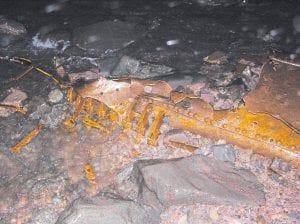Questions abound about the large piece of metal that lies half buried in sand and rocks on the shore of Lake Superior near Cutface Creek in the spot along Highway 61 commonly called the “Rock Cut.”
Is it from a shipwreck? Maybe a piece off a boat that had been purposely sunk in a nearby “ships” graveyard? Or is this from something else?
While some say the large piece of metal has long been seen at its present location, many beachcombers who pick agates on that beach can’t ever recall seeing it.
That all changed, however, after the big storm that blew through Cook County in late November. High winds coming from the south pushed the water into frenzy, and local beaches were pounded by strong waves. Those waves uncovered a large portion of metal with rivets.
Local resident Terry Backlund took several pictures of the oddity and his wife shared them with co-worker Kathleen Johnson. She in turn showed them to the Cook
County News-Herald
and asked how this material could be identified.
Call Tim Cochrane, director of the Grand Portage National Monument, he might know, or he might know someone who could come up with an answer, she was told.
Johnson sent Cochrane the pictures and Cochrane shared them with Dave Cooper, a long time maritime archeologist who used to work at Grand Portage.
Cooper, who now works at Apostle Islands National Lakeshore, told Cochrane he was fairly sure the metal was from a small to medium sized ship’s boiler or perhaps a large fish tug.
“The riveting gives him a clue as to age and its use. But the motor mechanism was not familiar to him,” Cochrane said.
Cooper, noted Cochrane, “used to run the state of Wisconsin’s underwater archeology program, so he’s seen a lot of fish tug engines. So I trust his judgment.”
But whose ship did this come from?
That won’t be known until the metal is unearthed enough for serial numbers to be found, if any numbers exist, that is. Those numbers could be traced back to the fabricator or ship maker and the age and size of the boiler could be determined.
But until then, the metal is a relic of a ship long sunk. A fragment now unearthed by the sands of time. Until the next big storm, when it might be covered again, and maybe something even more interesting gets pushed to the shore.



Loading Comments